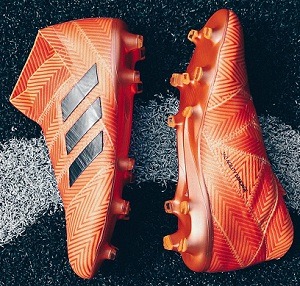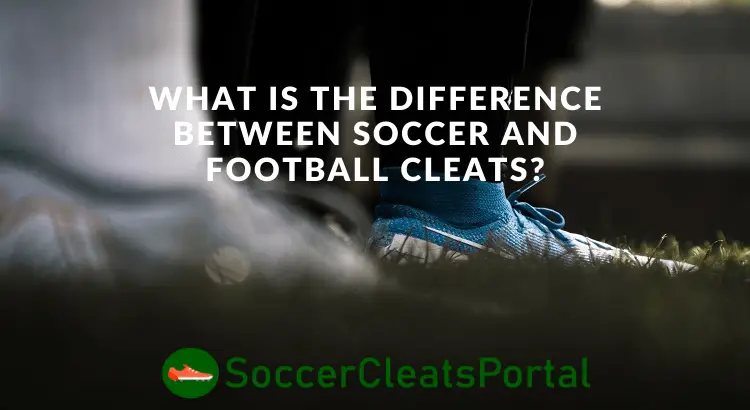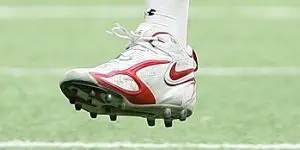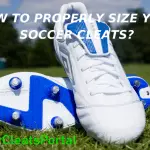Sports, like football and soccer, depend heavily on the athletic performance of the players. Both are very similar in different ways. They require the use of the feet to either run, jog, pull, stand, or stop another player. They also resemble each other since both must be practiced on similar surfaces such as natural or synthetic grass.
There are also other features that relate to these two popular sports, and one of them is clothing, specifically cleats. Lovers of both football and soccer know very well the type of footwear they should wear. Many other people do not know what kind of cleat should be used for soccer and which one should be used for football. That is why it is essential to take into account several factors, such as the surface, player’s ability, and the sport’s own demands.
If you are in a hurry, the main differences between football cleats and soccer cleats are:
- Style. Soccer cleats mainly have a low-cut style.
- Manufacture. Soccer cleats are lighter than football cleats.
- Toe stud. Football cleats have an extra toe stud near the big toe that does not appear in soccer cleats.
Although there are currently cleats of different colors, formats, and features, we must understand how soccer cleats and football cleats differ.
Soccer Cleats vs Football Cleats
Soccer Cleats | Football Cleats |
|
|---|---|---|
Style | Only low-cut | Low-cut, medium-cut or high tops depending on the position |
Manufacture | Lighter and narrower | Heavier and Wider |
Toe stud | Only two separate studs in the front of the shoe | An extra stud near the big toe |
- Style
The football and soccer cleats come in different styles according to the way of playing of each sport. Soccer cleats are low-cut style and have no toe spike. That means they are lightweight and have better maneuverability in the ankle area. This type of shoe allows players to stay closer to the ground and maintain balance. Soccer cleats may not offer the best ankle support but there are some pairs that can offer better ankle protection than others.
On the other hand, football cleats have an additional spike on the toe, allowing players to gain more momentum to jump. They present 3 different styles which are used depending on the position the player holds on the playing field:
- High tops: They are designed to support and cover the ankle and are mainly used by the linemen of the team.
- Medium-cut cleats: Highly recommended for players who cover a receiver, runner, quarterback, and defender positions. These cleats offer great support and maneuverability by covering only part of the ankle.
- Low-cut cleats: These are lighter than the other two previous styles and offer higher speed for defensive backs. Also, wide receivers wear them in order to increase their speed.
- Manufacturing
Soccer cleats are lighter than football cleats. That is due to the nature of the game. In soccer, players run throughout the match while moving the ball with their foot either by controlling it or passing it to another player. They are made of rubber or polyurethane soles so that they are resistant.
In addition, the upper part is made of leather or synthetic material. The manufacture of these cleats offers greater agility and speed to the players helping them to reduce fatigue during a soccer match.
American football players do not require cleats with the same features as football players since they do not have permanent contact with the ball. For that reason, football cleats are heavier and have thick soles. This type of sports shoes can be made of synthetic material or leather and must be resistant to withstand different terrains and climates.
This feature is unique to football cleats bottom. It consists of a toe stud near the big toe that provides better grip and traction as the player pushes or blocks another player.
Instead, the toe stud in a soccer cleat could hamper the handling and kicking of the ball.
You may have noticed soccer referees check the shoe of the player when they enter the pitch. Having an extra toe stud can cause injuries to opposite players when tackling for the ball. So wearing them is prohibited in professional soccer. 
- Feeling on the feet.
The soccer cleats are specially made so that the players have a natural sensation in the toe when they touch the ball. They allow a receptive feeling when receiving a ball and also when passing it to a teammate or shooting. Soccer cleats are generally narrower than football cleats so that might be a challenge for soccer players with wide feet to find a more suitable pair for them.
In the case of football cleats, this feature is not required unless the player is a kicker. These players generally run across the field without contact with the ball so they can user larger shoes.
Soccer cleats can also be similar with baseball and lacrosse cleats. I have written a different article with the difference between soccer and baseball cleats and one with the difference with lacrosse shoes.
Do Soccer Cleats Work for Football?
We have seen each of the differences and similarities between soccer cleats and football cleats. We can conclude that it is possible to use soccer cleats to play American football, but there are several aspects to consider. The position that each player occupies on the field is an essential factor.
The cleats of both sports are similar, but the differences they possess indicate the possibility of using soccer cleats to play American football in particular cases. The cleats are lightweight and have no toe spike making them perfect for specialized kicking football players. They are also recommended for wide receiver players since their style of play does not influence when wearing one shoe or another.
Now for defensive players, it would not be a good idea. The football cleats have a toe stud that the soccer cleats do not have. That toe stud allows players to block the tackler of the opposing team as it provides greater traction, stability, and control.
So can football players use soccer cleats? The answer is yes, but it will depend on the position of each player on the field of play.
But what are the official rules?
Here’s what the official NFL rules say regarding the player’s cleats.
“Article 3: Item 7. Shoes. Shoes must be of standard football design, including “sneaker” type shoes such as basketball shoes, cross-training shoes, etc..”
“Article 3:Item 5. Improper Cleats. Shoe cleats made of aluminum or other material that may chip, fracture, or develop a cutting edge. Conical cleats with concave sides or points which measure less than ⅜-inch in diameter at the tips, or cleats with oblong ends which measure less than ¼ by ¾-inch at the end tips are also prohibited. Nylon cleats with flat steel tips are permitted.”
So there is not any official written rule that prohibits football players from wearing soccers cleats. It all comes down to personal preference.
Can you wear soccer cleats for football?
The main reason that football cleats can not be weared for soccer is the extra two stud in the front toe. Is is useful in American Football for providing better traction for pushing but it does not have any practical value for the soccer players.
Furthermore, soccer players should avoid using football cleats as the extra toe stud might be dangerous for them and the other players.
Let’s look to official rulebook here too.
The Laws of the Game (LOTG) put forth by the International Football Association Board (IFAB) say the following:
– A player must not use equipment or wear anything dangerous. (Section 1)
– Footwear is “compulsory equipment.” (Section 2)
It is not written clearly but baseball cleat most likely referees will not allow you to wear football cleats for playing soccer as it might be considered dangerous. The same law above requires the referee to inspect each player’s equipment before the start of each match.
“The players must be inspected before the start of the match and substitutes before they enter the field of play. If a player is wearing or using unauthorized or dangerous equipment or jewelry, the referee must order the player to:
- remove the item
- leave the field of play at the next stoppage if the player is unable or unwilling to comply
A player who refuses to comply or wears the item again must be cautioned.”




